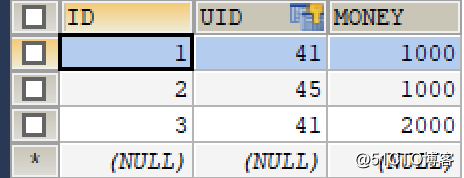Mybatis中的多表查询
1.mybatis中的表之间的关系分析
表之间的关系有: 1. 一对多 2. 多对一 3. 一对一 4. 多对多
2. 表关系举例
1. 用户和订单就是一对多 { 一个用户可以下多个订单 } 2. 订单和用户就是多对一 { 多个订单属于同一个用户 } 3. 人和身份证号就是一对一 { 一个人对应一个身份证号 一个身份证号只能对应一个人 } 4. 老师和学生之间就是多对多的关系 { 一个老师可以教多个学生 一个学生可以被多个老师教过 }
3. 注意:在Mybatis中,把多对一看成是一对一进行操作。
如:多个账户对应一个用户,那么每个账户都对应一个用户。所以在mybatis中把多对一看成是一对一进行操作
4. 多对一(mybatis中的一对一)、一对多、多对多三种方式在mybatis中的操作方式
多对一(mybatis中的一对一)
以账户Account和用户User为例。完成:查询所有账户的同时,查询出该账户对应的User用户
account表:
user表:
- 操作方式:【重点】
在多的一方(即account方)对应的实体类中加入一方(即user方)的对象引用
- 实体类代码:
public class Account implements Serializable { private Integer ID; private Integer UID; private Double MONEY; //从表实体应该包含一个主表实体的对象引用 //多对一关系,要在多的一方添加上一方的主键,作为多的一方的外键, // 在Java中要在多的一方加上一个一方的对象引用 private User user; ... }public class User implements Serializable { private Integer id; private String username; private Date birthday; private String sex; private String address; ... }
- IAccountDao接口
public interface IAccountDao { //查询所有账户的同时,查询出该账户对应的User用户 public List<Account> findAll(); }
- 接口映射文件配置
<?xml version="1.0" encoding="UTF-8"?>
<!DOCTYPE mapper
PUBLIC "-//mybatis.org//DTD Mapper 3.0//EN"
"http://mybatis.org/dtd/mybatis-3-mapper.dtd">
<mapper namespace="itlearn.zhi.dao.IAccountDao">
<!-- type:为当前进行配置的实体类名,在此使用了typeAliases标签,所以可以直接写类名,不区分大小写 -->
<resultMap id="accountUserMap" type="account">
> > <!--注意:在sql语句中给a.id取了别名,所以在这里也要 用别名配置 【重点】 -->
> > <id property="ID" column="aid"></id>
> > <result property="UID" column="UID"></result>
> > <result property="MONEY" column="MONEY"></result>
> > <!-- 对User属性进行配置,在此只要不是集合就使用association标签
> > colum:指的是该属性的值是通过数据库中哪个字段来获取的
> > JavaType:要封装成的类型。
> > -->
> > <association property="user" column="UID" javaType="user">
> > <id property="id" column="id"></id>
> > <result property="username" column="username"></result>
> > <result property="birthday" column="birthday"></result>
> > <result property="sex" column="sex"></result>
> > <result property="address" column="address"></result>
> > </association>
> > </resultMap>
> >
> > <select id="findAll" resultMap="accountUserMap">
> > <!-- 注意:因为在account和user表中都有id字段,在sql中需要起别名,防止resultMap中发生映射错误,同时也需要在resultMap中给取了别名的字段配置Colum-->
> > SELECT u.*,a.ID AS aid,a.UID,a.MONEY FROM account a ,user u WHERE a.UID = u.id;
> > </select>
> > </mapper>
- 一对多
- 也是以Account表和User表为例。完成:查询所有用户的同时,展示出该用户下所有账户信息
public class User implements Serializable { private Integer id; private String username; private Date birthday; private String sex; private String address; //一个用户有多个账户 //那么在一方需要加上一个多方的对象集合 private List<Account> accounts; ... }
- 操作方式
在一的一方的实体类中,加入多的一方的集合引用。即:在一的一方(User方)加入: private List<Account> accounts;
- IUserDao接口
public interface IUserDao { //查询所有用户,并查询到该用户下所有账户信息 public List<User> findAll(); }
- 接口映射配置文件中的配置
> > > <?xml version="1.0" encoding="UTF-8"?>
> > > <!DOCTYPE mapper
> > > PUBLIC "-//mybatis.org//DTD Mapper 3.0//EN"
> > > "http://mybatis.org/dtd/mybatis-3-mapper.dtd">
> > > <mapper namespace="itlearn.zhi.dao.IUserDao">
> > > <resultMap id="userAccountMap" type="user">
> > > <id property="id" column="id"/>
> > > <result property="username" column="username"></result>
> > > <result property="birthday" column="birthday"></result>
> > > <result property="sex" column="sex"></result>
> > > <result property="address" column="address"></result>
> > > <!-- 因为使集合引用,所以要用collection标签,如果不是集合就用association标签
> > > ofType:指定当前要封装的类型
> > > -->
> > > <collection property="accounts" ofType="account">
> > > <!-- 因为在sql语句中为a.id起了别名,所以在这里也要用别名配置 -->
> > > <id property="ID" column="aid"></id>
> > > <result property="UID" column="UID"></result>
> > > <result property="MONEY" column="MONEY"></result>
> > > </collection>
> > > </resultMap>
> > >
> > > <select id="findAll" resultMap="userAccountMap">
> > > SELECT u.*,a.id as aid,a.UID,a.MONEY FROM USER u LEFT OUTER JOIN account a ON u.`id` = a.`UID`;
> > > </select>
> > > </mapper>
- 结果显示:
----------------------- User{id=41, username='老王', birthday=Tue Feb 27 17:47:08 CST 2018, sex='男', address='北京'} [Account{ID=1, UID=41, MONEY=1000.0}, Account{ID=3, UID=41, MONEY=2000.0}] ----------------------- User{id=42, username='小二王', birthday=Fri Mar 02 15:09:37 CST 2018, sex='女', address='北京金燕龙'} [] ----------------------- User{id=45, username='传智播客', birthday=Sun Mar 04 12:04:06 CST 2018, sex='男', address='北京金燕龙'} [Account{ID=2, UID=45, MONEY=1000.0}] ...可见:[Account{ID=1, UID=41, MONEY=1000.0}, Account{ID=3, UID=41, MONEY=2000.0}]mybatis会自动帮我们把用户下面的多个账户进行封装进集合。
- 多对多:在多对多的关系中,会有一张中间表的存在,并且存放的是两个表的主键
- 以User和Role表为例
Role表:
- 操作方式
在两张表对应的实体类中分别加入对方的集合引用【重点】
- Role实体
public class Role implements Serializable { private Integer id; private String roleName; private String roleDesc; private List<User> users; ... }
- User实体
public class User implements Serializable { private Integer id; private String username; private Date birthday; private String sex; private String address; private List<Role> roles; ... }
- 实现1:在查询所有用户的同时查询出该用户的角色信息. 接口方法:findAll
> > > <?xml version="1.0" encoding="UTF-8"?>
> > > <!DOCTYPE mapper
> > > PUBLIC "-//mybatis.org//DTD Mapper 3.0//EN"
> > > "http://mybatis.org/dtd/mybatis-3-mapper.dtd">
> > > <mapper namespace="itlearn.zhi.dao.IUserDao">
> > >
> > > <resultMap id="userRole" type="user">
> > > <id property="id" column="id"/>
> > > <result property="username" column="username"></result>
> > > <result property="birthday" column="birthday"></result>
> > > <result property="sex" column="sex"></result>
> > > <result property="address" column="address"></result>
> > > <collection property="roles" ofType="role">
> > > <id property="id" column="rid"></id>
> > > <result property="roleName" column="ROLE_NAME"></result>
> > > <result property="roleDesc" column="ROLE_DESC"></result>
> > > </collection>
> > > </resultMap>
> > >
> > > <select id="findAll" resultMap="userRole">
> > > SELECT u.*,r.`ID` AS rid,r.`ROLE_NAME`,r.`ROLE_DESC` FROM USER u LEFT JOIN user_role ur
> > > ON u.`id` = ur.`UID`
> > > LEFT JOIN role r
> > > ON ur.`RID` = r.`ID`;
> > > </select>
> > > </mapper>
- 查询结果:
User{id=41, username='老王', birthday=Tue Feb 27 17:47:08 CST 2018, sex='男', address='北京'} [Role{id=1, roleName='院长', roleDesc='管理整个学院'}, Role{id=2, roleName='总裁', roleDesc='管理整个公司'}] ----------------------- User{id=42, username='小二王', birthday=Fri Mar 02 15:09:37 CST 2018, sex='女', address='北京金燕龙'} [] ----------------------- User{id=43, username='小二王', birthday=Sun Mar 04 11:34:34 CST 2018, sex='女', address='北京金燕龙'} [] ----------------------- User{id=45, username='传智播客', birthday=Sun Mar 04 12:04:06 CST 2018, sex='男', address='北京金燕龙'} [Role{id=1, roleName='院长', roleDesc='管理整个学院'}] ...
- 实现2:在查询所有角色的同时查询出该角色下的用户信息. 接口方法:findAll
> > > <?xml version="1.0" encoding="UTF-8"?>
> > > <!DOCTYPE mapper
> > > PUBLIC "-//mybatis.org//DTD Mapper 3.0//EN"
> > > "http://mybatis.org/dtd/mybatis-3-mapper.dtd">
> > > <mapper namespace="itlearn.zhi.dao.IRoleDao">
> > > <resultMap id="roleUser" type="role">
> > > <id property="id" column="rid"></id>
> > > <result property="roleName" column="ROLE_NAME"></result>
> > > <result property="roleDesc" column="ROLE_DESC"></result>
> > > <collection property="users" ofType="user">
> > > <id property="id" column="id"/>
> > > <result property="username" column="username"></result>
> > > <result property="birthday" column="birthday"></result>
> > > <result property="sex" column="sex"></result>
> > > <result property="address" column="address"></result>
> > > </collection>
> > > </resultMap>
> > >
> > > <select id="findAll" resultMap="roleUser">
> > > SELECT r.`ID` AS rid,r.`ROLE_NAME`,r.`ROLE_DESC`,u.* FROM role r LEFT JOIN user_role ur
> > > ON r.`ID` = ur.`RID`
> > > LEFT JOIN USER u
> > > ON ur.`UID` = u.`id`;
> > > </select>
> > > </mapper>查询结果:
Role{id=1, roleName='院长', roleDesc='管理整个学院'} [User{id=41, username='老王', birthday=Tue Feb 27 17:47:08 CST 2018, sex='男', address='北京'}, User{id=45, username='传智播客', birthday=Sun Mar 04 12:04:06 CST 2018, sex='男', address='北京金燕龙'}] ----------------------- Role{id=2, roleName='总裁', roleDesc='管理整个公司'} [User{id=41, username='老王', birthday=Tue Feb 27 17:47:08 CST 2018, sex='男', address='北京'}] ----------------------- Role{id=3, roleName='校长', roleDesc='管理整个学校'} []
5. 多表操作总结
- 多对一:在多的一方加入一方的对象引用;private User user; 在resultMap中使用:association标签对user进行配置
- 一对多:在一的一方加入多的一方的集合引用:private List<Account> accounts;在resultMap中使用:collection标签对accounts进行配置
- 多对多:在每一方的实体类中加入另一方的集合引用。在resultMap中使用:collection标签对集合引用进行配置


